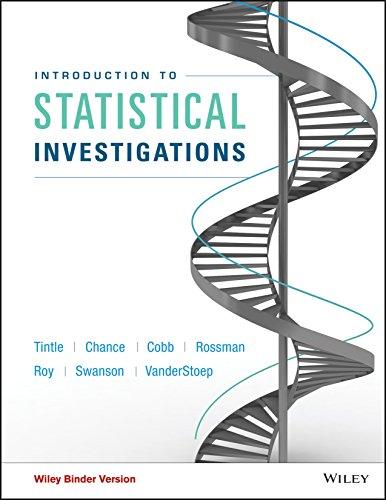Reconsider the study mentioned in the previous exercise about guessing the size of Milwaukees population. Do the
Question:
Reconsider the study mentioned in the previous exercise about guessing the size of Milwaukee’s population. Do the data provide evidence of the anchoring phenomenon among students like the ones in this study? Suppose that instead of comparing the average guess for Milwaukee’s population (Chicago vs. Green Bay), we wanted to compare the median guesses. Recall that the data set is titled Milwaukee and that the first column contains the city mentioned to subjects and the second column contains the guesses for the population of Milwaukee (in thousands, to the nearest thousand).
a. Use an appropriate randomization-based applet to find a p-value to test whether there is strong evidence of the anchoring phenomenon among students like the ones in this study. Report and interpret the p-value in the context of the study.
b. Use the p-value to indicate the strength of evidence against the null hypothesis.
c. Calculate an appropriate standardized statistic and interpret the standardized statistic in the context of the study.
d. Use the 2SD method to find a confidence interval for the parameter of interest. Report this interval and interpret the interval in the context of the study.
e. Do the results from the 95% confidence interval agree with your conclusion in part (b)? How are you deciding?
f. Give a full conclusion, including significance, estimation, causation, and generalization.
Data from previous exercise
Do the data provide evidence of the anchoring phenomenon among students like the ones in this study? That is, our research question is: On average, will students like the ones in the study tend to guess a higher population size for Milwaukee if they are told about Chicago’s population size rather than told Green Bay’s population size? Recall that the data set is titled Milwaukee and that the first column contains the city mentioned to subjects and the second column contains the guesses for the population of Milwaukee (in thousands, to the nearest thousand).
Anchoring is “the common human tendency to rely too heavily, or ‘anchor,’ on one trait or piece of information when making decisions.” (Source: Wikipedia.) A group of students taking an introductory statistics course at a four-year university in California were asked to guess the population of Milwaukee, Wisconsin. Some of the students were randomly chosen to be told that the nearby city of Chicago, Illinois has a population of about 3 million people, while the rest of the students were told that the nearby city of Green Bay, Wisconsin, has a population of about 100,000. Previous studies have shown that these numbers serve as a psychological anchor, so people told about Chicago tend to guess a higher population for Milwaukee than people told about Green Bay. (For more about this phenomenon, see the book Nudge: Improving Decisions about Health, Wealth, and Happiness by Richard H. Thaler and Cass R. Sunstein.) The purpose in analyzing the data is to see if we find strong evidence of this phenomenon among students like the ones in this study.
Step by Step Answer:

Introduction To Statistical Investigations
ISBN: 9781118172148
1st Edition
Authors: Beth L.Chance, George W.Cobb, Allan J.Rossman Nathan Tintle, Todd Swanson Soma Roy





